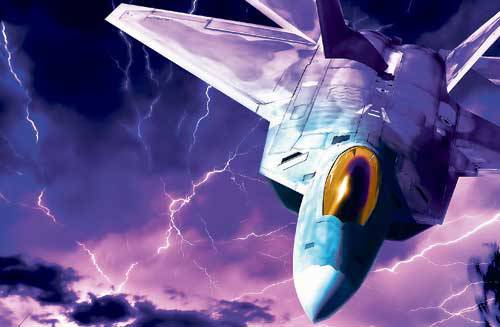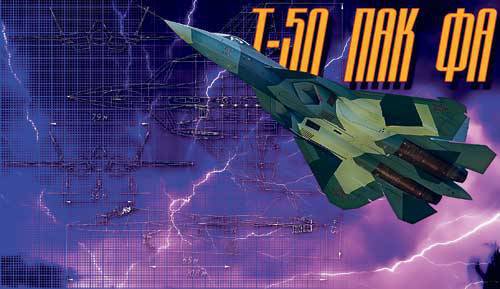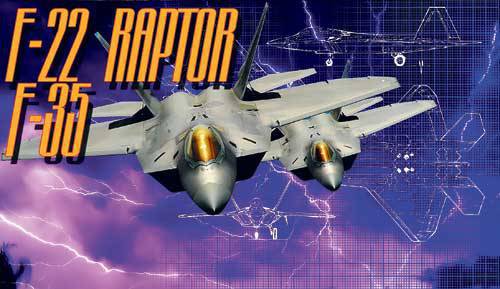Chasing the United States

January 29 2010 for the first time flew into the air experienced Russian fighter T-50 Sukhoi Design Bureau. Flying a new car marked the next stage of a long stories fifth generation domestic aircraft, which began more than 30 years ago.
Requirements for a future front-line car aviation The leadership of the USSR Air Force was originally formulated at the turn of the 70s and 80s, when tests of fourth-generation fighters, the MiG-29 and Su-27, were still underway. In fact, work on a promising aircraft in the Soviet Union and the United States began at the same time, and our designers sought to endow it with approximately the same qualities that are listed in the material of Konstantin Bogdanov about American aircraft.
FAIL START
The first domestic project of the fifth generation fighter was the topic "I-90" by the Mikoyan Design Bureau (autumn 1979 of the year). It should be noted that at this stage, the customer, as in the United States, has not yet prepared a tactical and technical mission for this aircraft. It was clear that its capabilities would be radically different from the machines of the previous models, and before developing the TTZ, the military on both sides of the ocean wanted to understand what the latest technologies embodied in the upcoming project could give them.
The tactical and technical requirements for the I-90 were issued in 1983 year, when it was possible to determine the characteristics of the future aircraft, its avionics and weapons. In 1987, the advance project protection stage was completed, in 1991, the preliminary design of the MFI (multifunctional front-line fighter, the name was given to the subject) and the mock-up of the fighter were protected.
The machine, unlike previous combat aircraft of the front-line aviation of the Mikoyan Design Bureau, was bulky: the maximum take-off weight in 35 tons put it between the Su-27 and the heavy MiG-31 air defense interceptor. It is characteristic that the competing project of the Sukhoi Design Bureau, as well as American projects YF-22 and YF-23, created under the ATF program, turned out to be plus or minus in the same weight category.
The most convincing explanation for this “heavyweight” of promising machines is the desire for universality of new aircraft and the desire to increase their combat capabilities due to both high combat load and the placement of more powerful (and hence more large-sized) electronic equipment.
The first flight of the Mikoyan fighter waited a long time: after taxiing 1993-1994 in the winter, the aircraft that received the MiG 1.44 index rose to the sky only in February 2000 - after the collapse of the USSR, the pace of development of the new technology was extremely slow.
This slowdown was fatal in the fate of the IFI: during its refinement, aviation technologies advanced, approaches to ensuring inconspicuous machine, ideas about the most optimal layout, etc., changed. As a result, the Mikoyan Design Bureau aircraft was prepared for the role of a flying laboratory.
A little later than the I-90, in 1983, simultaneously with the issuance of the Air Force TTZ, the Sukhoi Design Bureau project started, finally completing the most difficult work of redesigning the T-10 / Su-27 machine. Already burned due to excessive conservatism in choosing the layout of the T-10, which led to a deterioration in the flight performance of the vehicle compared to competing aircraft and required an almost complete redrawing of the project, the OKB engineers decided to rehabilitate on a new fighter, adopting an unconventional layout with a backward sweep of the wing and as widely as possible using composite materials.
This plane was developed for five years as part of the Air Force program for researching machines with reverse sweep, and after the program was closed in 1988, the aircraft continued to be built for the USSR Navy aircraft, which needed a deck fighter.
When the Soviet Union collapsed, the work was done at the expense of the design bureau itself, which managed to lift the car into the air in 1997. The plane, which received the designation C-37 (later changed to Su-47 "Berkut"), made a very big impression on both Russian and foreign specialists. Su-47 was much closer to the specified requirements, and it was the exceptional capabilities of this machine, combined with the much better state of the design bureau as a whole, that predetermined the choice of Sukhoi as the lead developer of the fifth generation fighter, which was launched in 2002 year.

PAK FA: CONSCIOUSNESS OF THE PASSED
The beginning of 2000-ies was marked by the growth of the Russian economy and, as a consequence, an increase in military spending. Under these conditions, the issue of a combat winged machine of the future was again on the agenda in the Ministry of Defense of the Russian Federation. Thus was born the program PAK FA - a promising aviation complex of front-line aviation. The fighter, which from the middle of the decade became the invariable hero of the military-technical press, was known by many names: the product 701, I-21, T-50. Prospects for its creation were very serious doubts, aggravated by the postponement of the first flight, which was first expected in 2007, then in 2008, and finally in 2009 ... Uncertainty was added by the unclear situation with the engine for a promising car.
The project was developing in the meantime, and I must say that, compared to previous programs, the PAK FA had the most solid foundation: it was based on the considerable amount already accumulated in the development and testing of two prototypes of the Mikoyan Design Bureau and the Sukhoi Design Bureau. At the same time, Berkut was actively involved in the development of the PAK FA to test a number of layout solutions and to test new systems. Foreign experience also had a significant impact on the development of the aircraft: in particular, many experts see a lot in common between the Sukhoi car and the American YF-23 prototype, the unlucky rival YF-22, which, despite losing the tender, deserved very high marks from experts.
I took into account the example of "Raptor". The extensive contacts of engineers from the design bureau, which had turned into Sukhoi AHK, with colleagues from other countries, in particular during the implementation of the Sukhoi Superjet civil aircraft project, greatly contributed to acquaintance with foreign experience.
As a result, the creators of the T-50 could go ahead with their eyes open. An additional safety net was the development of the Su-2000BM (Su-35С) fighter in the second half of the 35-s, equipped with equipment similar to or similar to what is planned to be used on a fifth-generation machine.
Successful tests of the Su-35С and the beginning of their mass production for the Russian Air Force demonstrated the correctness of the chosen path. In addition, the reliability of the T-50 project increases the availability of backup options for each of the aircraft’s key systems. So, to achieve a T-50 off-board cruising supersonic, the existing “intermediate” 117 engines suffice, which makes it possible to calmly wait for the development of their new-generation analogues designed specifically for the T-50.
The 117 engines of NPO Saturn are based on the AL-31 family. They differ from their predecessors by an increased burden and resource.
By the way, the power plant itself cannot serve as a criterion for attributing a car to one or another generation. Suffice it to recall, for example, the fourth-generation main interceptor fighter of the United States Navy F-14 Tomcat. It took off for the first time in 1970, and the serial production of the F110-GE-400 engines specially developed for it began almost 20 years later - in the 1989 year.
As a result, only 37 machines were built with these engines, and 50 received them during modernization. All the other fighters for almost 20 years of mass production were completed with TF30-P-414A engines, which were initially viewed as a temporary measure, but eventually turned into the main engines for this aircraft. Such a “substitution” led to a slight decrease in flight performance compared to the calculated ones, but did not prevent the F-14 from becoming one of the best machines of its generation.
There are other “T-50” key nodes that have “duplicate options”, which makes it possible to count on the success of the program as a whole with a very high probability and indicates the possibility of upgrading the aircraft in the future.
As a result, the fighter undergoing tests today, many experts, including foreign ones, are called a very promising platform. In the future, the T-50 is able to serve as the basis for a whole pleiad of airplanes like Sukhoi’s previous development, the T-10, which spawned the Su-27 branch tree and its modifications.
We can safely say that the PAK FA project was saved thanks to the participation of the Sukhoi company. The creators of the most commercially successful family of combat winged vehicles of the last 20 years were the only specialized structure in Russia capable of “drawing out” the development of a fundamentally new fighter and possessing the scientific, financial and production resources necessary for such a project, as well as the level of organization.
CHOICE OF CONTRACTOR
Indian air forces became interested in Russian work on promising fighters very quickly. Such close attention to the fifth generation aircraft is easily explained: a country that claims leadership among the states located on the shores of the Indian Ocean and a leading position in the Asia-Pacific region, which has not too friendly neighbors (Pakistan and China), has to maintain its military aviation on due level.
At the same time, the Russian version was and by and large remains uncontested. There are no fifth generation fighter projects in Europe and will not be expected in the near future. The American F-22, even if it doesn’t touch on the issue of its cost, is not exported, and the promising F-35 is still unable to break out of the growing tangle of problems - technical, financial, etc.
It should be noted that initially the sympathies of India tended towards the project of a lighter and simpler fighter of the OKB Mikoyan, which for the new competition offered two versions of the machine - the twin-engine “tailless” I-2000, which is a creative development of the MiG-29 platform, and a single-engine vehicle, the closest analogue of which You can call the JSF project (F-35) that appeared at about the same time.
However, soon the fifth generation light fighter project was declared secondary and India, who wanted to get the newest machine in the foreseeable future, had to join the PAK FA program, choosing Sukhoi aircraft for the role of FGFA (fifth generation fighter aircraft).
The Indian version of the car, according to available information, will differ from the Russian fighter by a double cabin, a number of electronic systems and other secondary equipment. These aircraft in the 2020-2030 years are expected to replace the Su-30MKI. It is expected that licensed production of machines will be launched in India. At the same time, according to available information, Delhi intends to attract foreign manufacturers, including the largest Western companies, to modernize the aircraft, which theoretically could make FGFA more successful on the market than the original T-50.

WITH WHOM COMPETIES T-50
In total, India intends to purchase at least 10 FGFA machines within 12-200 years. Several large batches of fighters should arrive in the Russian Air Force (including the 60 - before the 2020 of the year). In general, the demand of the global aircraft market for aircraft of this class is estimated by the Sukhoi design bureau experts at about 1000 units, while the T-50 has every chance to satisfy it. The closest competitor to the T-50 is the US F-22, which is currently not being produced, and the export of Raptor, as mentioned above, is prohibited by law.
Comparison with the other fifth-generation F-35 aircraft being tested, which, on the contrary, is supposed to be actively sold outside the US, quite clearly demonstrates the advantages of our fighter. At a lower price, the T-50 is much wider at the expense of superiority in combat load and range of weapons. In addition, the T-50 as a whole is a machine created with a much lower degree of technical risk compared to the F-35, which, especially in the F-35B variant, is built literally “on the edge of technology”. This edge is felt very well in the new and new problems of the Lightning - from the design (in the form of "busting" in the mass of the fighter) to the industrial production that pops up under the guise (for example, frequent and sudden breakdowns of seemingly long-overdue aircraft components).
But even in the absence of restrictions similar to those imposed on the export of F-22, the free purchase of American military equipment at a reasonable price is the lot of the main US allies, which can not be attributed, for example, the same India.
FLYING TIGERS UNFELT
Just like Russia and the United States, the PRC realized the need to develop a fifth-generation fighter rather early in the 80s. Chinese engineers started conceptual studies on this program in 1989. Specialists from leading aviation research institutes of the country were involved in the work: 611-th in Chengdu and 601-th in Shenyang.
The normalization of relations between Moscow and Beijing, which took place throughout the end of the 80-90-s, opened the PRC access to the Russian reserves. The Chinese used the knowledge and experience of SibNIA employees (Siberian Branch of TsAGI, Novosibirsk). By the way, in addition to providing practical assistance in designing the new aircraft, they participated in the modernization of the cars produced in the Middle Kingdom, as well as in the alteration under the Chinese requirements of the Israeli project Lavi, launched into the series under the symbol J-10. Representatives of other developed aviation powers, including Antonov Design Bureau, Boeing and Airbus Industry, were not left aside.
Information about the Chinese fifth-generation aircraft is extremely contradictory. According to one version, the PRC is developing a twin-engine heavy fighter that is “in the same category” with the F-22 and T-50. In the 2008 year, however, it was reported that a lightweight fighter was also being created in the Celestial Empire - something like the analogue of the F-35. True, the prospects for success are being questioned here: it’s difficult to work on this machine in the US, and therefore it’s impossible to rely on the fact that China will be able to quickly solve the most complicated complex of technical and economic issues.
POSSIBLE FUTURE MOCKET
In addition to the United States, today only Japan has become a post-industrial state, intent on acquiring a fifth-generation car of its own. The only information available to the “masses” about the project is a photograph of the layout of the new aircraft on the factory floor. At the same time, Tokyo is one of the customers of the F-35 fighter, which should be based, in particular, on the promising light aircraft carriers of the Japanese Navy.
The country of the rising sun, of course, has the potential necessary for the design and creation of promising aviation complexes, but here the question arises of the economic feasibility of such expenses. It is obvious that work on a fighter, similar in capabilities with the T-50 and F-22, will be very expensive.
Meanwhile, there is no particular need for such a “feat” - the US is ready to come to the aid of its Far Eastern ally if Japan is attacked. As a result, the development of the fifth generation aircraft could be a political step for it to some extent, which would mean Tokyo’s desire for greater independence from Washington.
INSTEAD OF EPILOGUE
The division of post-war combat aircraft into generations may not be the best way to classify, but very visual. There is perhaps no better illustration of the approach of modern industry to the technological barrier than the narrowing of the circle of countries independently developing and building combat winged cars belonging to the next new generation. Even more visual evidence is a reduction in the number of manufacturing companies and, accordingly, projects.
Each next generation of combat aircraft requires more time to develop (despite the staggering increase in computing power) and costs many times, and even an order of magnitude more expensive than its predecessors. Currently, every slight improvement in performance characteristics is costly and is not always possible in principle.
The last time such a barrier arose in front of piston aircraft in the 40s of the last century and was overcome by the transition to jet aviation. It could take dozens of years “in the usual mode”, but it took place in the military aviation of developed countries in five years, and in the civil one — in 15 years, thanks to the tremendous power of the impetus that World War II gave to the development of technology.
Today, an armed confrontation of the same magnitude is unlikely to give such an impulse, rather it will lead to the destruction of industrial civilization, therefore it will be necessary to overcome the barrier in manual mode. How long it will take, as well as how it will end, until nobody undertakes to predict.
Information